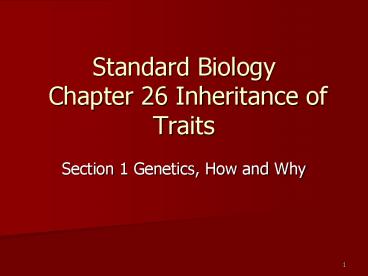Standard Biology Chapter 26 Inheritance of Traits - PowerPoint PPT Presentation
1 / 21
Title:
Standard Biology Chapter 26 Inheritance of Traits
Description:
Standard Biology Chapter 26 Inheritance of Traits Section 1 Genetics, How and Why * * Genetics Genetics: the study of how traits are passed from parent to offspring ... – PowerPoint PPT presentation
Number of Views:113
Avg rating:3.0/5.0
Title: Standard Biology Chapter 26 Inheritance of Traits
1
Standard Biology Chapter 26 Inheritance of Traits
- Section 1 Genetics, How and Why
2
Genetics
- Genetics the study of how traits are passed from
parent to offspring - Mystery for a long time
- Now know traits are passed in sex cells
3
Chromosomes
- Nucleus found in center of cell which directs the
cells activities - Chromosomes are found in nucleus
- Chromosomes are thickened and easy to see
- Remember, chromosomes are duplicated before cell
reproduction
4
Chromosomes
- Two kinds of cells
- Body cells- chromosomes in pairs (diploid)
- Sex cells- single chromosomes (so ½ the number of
chromosomes as body cells) (haploid)
5
Genes on Chromosomes
- Gene
- Small section of chromosome that determines a
specific trait examples - Eye color
- Wing shape
- Chemical process
- Humans have about 23,000 genes
6
Genes on Chromosomes
- Genes are arranged on a chromosome like beads on
a necklace - Chromosomes are paired, so genes are paired
(except sex cells)
7
Passing Traits to Offspring
Female egg
- Traits are passes from parent to offspring in sex
cells - Example Ear Lobe Shape p. 548
A
A
AF
F
Child will have free ear lobes
F
Male sperm
A attached ear lobes F free ear lobes
8
Dominant and Recessive Genes
- One trait dominates another like free dominates
attached - Freedominate and Attachedrecessive
- Mother is pure attached (AA) or homozygous
recessive (homo means same) - Father is pure dominate (FF) or homozygous
dominate - Child is one Free and one Attached (FA) or
heterozygous (hetero means different)
9
Traits of Plants and Animals
Trait found in Dominant Trait Recessive Trait
Flies Long wings Short wings
Pea plants Purple flowers White flowers
Humans Can roll tongue Cant roll tongue
Corn plants Normal height Dwarf
Dogs Short hair Long hair
10
When Both Parents are Heterozygous
- If mother is heterozygous (FA), she can make F
eggs and A eggs - If father is Heterozygous (FA), he can make F
sperm and A sperm - How many combinations of traits in children as
possible? Table 26-2 p. 551
11
When Both Parents are Heterozygous
- Mothers eggs F and A
- Fathers sperm F and A
- Child FF, FA, AF or AA
- So four combinations of genes possible (although
FA and AF are the same) - Child will have free ear lobes if FF, FA or AF
- Child will have attached ear lobes if AA
12
Standard Biology Chapter 26 Inheritance of Traits
- Section 2 Expected and Observed Results
13
Punnett Square
- Easy way to look at combinations of traits is
with a Punnett Square - Letters used represent genes
- Capital letters dominant
- Lower case letters recessive
- Traits letter based on dominant
14
Punnett Square
Mothers genes
- Example
- Free ear lobes dominant F
- Attached ear lobes recessive f
- Homozygous recessive mother ff
- Homozygous dominant father FF
f
f
F
Ff
Ff
Ff
F
Ff
Fathers genes
15
Punnett Square
Mothers genes
- Example when parents are heterozygous
F
f
F
Ff
FF
Fathers genes
ff
f
Ff
16
Directions for Punnett Square
- Draw a Punnett Square (4 boxes). Each box shows
possible combination of genes in offspring. - Decide what genes will be in the sex cells of
each parent. - Write mothers genes on top write fathers genes
on side. - Copy the letters that appear at the top of the
square into the boxes below each letter. - Copy the letters that appear at the side into the
boxes next to each letter. - Look at the 4 small boxes in the Punnett Square,
these are possible combinations in the offspring.
17
Expected Results
- Get from Punnett Square
- What you expect to happen
- Probability
Expected Results
18
Observed Results
Expected Results
- The numbers you actually get
- They dont match up exactly with what you expect
- The greater the number of offspring, the closer
you should get to the expected results. - Table 26-3 p. 557
Observed results when you count the pods of this
one cross 71 yellow pods and 24 green pods
19
Mendels Work
- Gregor Mendel
- Father of Genetics
- 1865 Austrian monk/teacher in Czech
- Grew garden peas, came up with ideas about how
traits are inherited - Counted 1000s of traits in pea plants and
conducted scientific investigations (applied math
to science)
20
Mendels Work
- Traits he studied
- Plant height
- Pod colorPod shape
- Seed color
- Seed shape
- Flower color
- Flower position
- Always found 3 dominate to 1 recessive when
heterozygous parents were crossed
21
(No Transcript)































